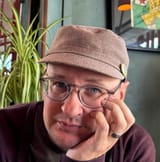Long May You Run (1976)
in which we agree this album only has one song on it
What’s good and bad about Neil is he could strike gold just as much as crash and burn. Which explains how he could record Zuma, one of his best, most beautiful albums, then follow-up it with this shit (right before sitting down with Briggs to record the incredible Hitchhiker session, no less). To be clear, this album has one good song on it, it’s the song everyone knows, the song he’s played on Conan and at the Olympics. It’s about his first car, the old hearse Mort. Yes, the title is a pun. The album is named after this song and it’s a pun. The rest of the album sucks. Not only does it suck, it’s embarrassing. I’m not going to write about the rest of the album because I honestly can’t stand to listen to it again.
In 1963, Neil was playing with a band called The Squires in Winnipeg, a vaguely surf guitar outfit. He asked his mother Rassy to help him buy a car. After checking out the large black doors and rollers in a 1948 Buick Roadmaster hearse, he said “Perfect for our equipment!” As he relates in his second memoir Special Deluxe, the hearse he named Mort gave the band an identity and more importantly a way to play further and further destinations. Notably, Mort would last until 1965 (not 1962 as the song says) when it did indeed break down in Blind River. This was the first hearse called Mort, not to be confused with the second hearse called Mort that Neil drove to Los Angeles and encountered Stephen Stills in.
Stills remains very close to Neil (they apparently jam together every week to this day). They’ve had a complicated relationship at various times but there’s always been a lot of affection. It’s not surprising they tried to make an album together. By all accounts, it was not exactly a collaboration, though. Neil would record his parts during the day, and Stills would record his parts at night. The subsequent tour furthered that divide and eventually Neil would just leave it on the way to a date, telling Stills to “Eat a peach” in a telegram. It was no longer fun for Neil, apparently. Given the majority of Long May You Run, I don’t blame him. Don’t get me wrong, Stills is an incredible songwriter, singer, and guitarist, but his bloated ego runs rampant on these awfully cheesy and self-serving songs. How the hell do you follow up a tender, gorgeous song like the title track with the insane “Make Love to You?” I digress.
“Long May You Run” is a lovingly composed song that flows effortlessly. It’s no wonder it’s become such an enduring radio staple. There’s something carefree about it. I wish he had just put this song somewhere else as it’s earnestness doesn’t fit with the overblown Stills lyrical content (Neil’s other songs on here aren’t that great either, though).
Top 3:
- Long May You Run
- -
- -
Cut song: everything except Long May You Run. Just delete this album and put that song on another album of this period. Hitchhiker, American Stars ‘n’ Bars, or Comes a Time.
Look Out for My Love is the 9th disc of Neil Young Archives Vol. 2 and contains a couple songs recorded during the Long May You Run sessions that could have made the released album much better. Notably the Homegrown song “Separate Ways” appears here, but with the Stills-Young Band. It’s great! Very different feel than the laconic Homegrown version, with prominent organ and guitar that gives it a bigger sound. Neil’s solo is super soulful and just soars like nothing else on the album. Jerry Aiello’s organ solo is a bit cheesy and Stills of course has to noodle his own solo, but honestly this track is better than the entire Long May You Run album. Also somewhat better is a track without a studio home: “Traces.” There’s a solo performance of it from the On The Beach sessions, but it never quite fit on an album, I guess. The solo version is better overall, but I would have taken this Still-Young Band version on Long May You Run instead of…well, anything but the title track. There’s also a sleepy version of “Human Highway” with the entire CSNY crew which is…eh, it’s nice, but I think Neil has recorded this song better elsewhere (and with CSNY). Perhaps most successful is the eventual studio version on Comes a Time. What could have been, though.

